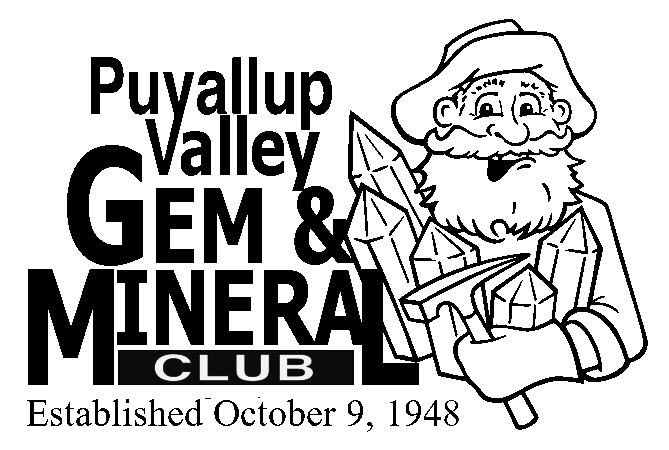
Rock Space Needle History
The following information was received by letter from Glen Knox regarding the history of the Rock Space Needle.
During 1961, members of the Puget Sound Gem & Mineral Club (PSG&MC) decided to combine their lapidary skills to create a large project. The newest addition to the Seattle skyline, the Space Needle, had been built and was the talk of the town. A decision was made to build a smaller version of the Space Needle. Two club members (one was George Hoddinott) went to the builder of the original Space Needle to ask for assistance with the dimensions. They got blueprints of it and decided to build the replica in ⅛ inch scale, which would create a piece with good detail and height.
The actual construction site for the Rock Space Needle was in George’s living room. It must have been quite the conversation starter! By the completion of the project, approximately 40 members assisted in the grinding and polishing of the pieces required to build the replica. Each person was given an exact drawing, with the size and number of pieces required, so a specific segment of the construction could be completed.
According to a PSG&MC newsletter dated November 1977, the following members were the original construction crew for what was to become an acclaimed treasure of the rockhound world, the Rock Space Needle.
Archie Sinclair, Betty Uhlman, Bill Murray, Bob Hagy, Cecil Fulmer, Cles Plank, Derry Fulmer, Doyle Davis, E. Fisher, Ed Dalsing, Ed Welch, Edity Heilman, Eleanor Sinclair, Eric Arvidson, Fred Teachout, Fran Thompson, Frank Miller, Frank Sitton, George Hoddinott, Glen Uhlman, Gus Plank, Hans Thiel, Harold Fullick, Henry Mayer, Jerry Hamm, Johnny Beauteau, June Olson, Les Roeth, Lyle Fowler, Lynette Dalsing, Noble Thompson, Otis Bienz, Paul Ater, Rella Welch, Stan Heilman, Stan Olson, & William Kryzak.
In April of 1962, the Rock Space Needle was first presented to the public at a show
called “Gems in Space.” It traveled to the show in the back of a truck with two people
holding it upright. It did not have its plexiglass cage as it does today and was prone to
children shaking it by the leg. Since it was newly- constructed, fortunately it held up to
the shaking just fine.
Though no records were kept on how many hours were involved, it is estimated that 3,000 hours went into its creation. Can you imagine how many cutting and grinding wheels, how much polishing compound, how many pounds of rock and how much epoxy went into the completion of the product? There must have been many rejected pieces as the members toiled on their project trying to make it as accurate as possible. We will never know, although we do have some specifics on the finished project. It is 75-½ inches high, weighs 150 pounds and is constructed on a scale of ⅛ inch = 1 foot.
Soon, it was clear to club members that moving the Space Needle replica needed to be less cumbersome. A box was built for the needle and restaurant sections and nicknamed the coffin. After some minor adjustments to the padding inside, it became the receptacle for storing and moving the major part of the Needle. The base is transported separately. The plexiglass cage, which was added later, also has its own storage box. Every time the Rock Space Needle needed to be moved, a volunteer with an 8 foot truck bed and 4 strong people moved and set it up inside its protective acrylic case.
There was much discussion on the part of the PSG&MC as to what to do with the Rock Space Needle. It was only being shown one to two times a year, mainly at shows. The club searched for a place that could display it year round. The secretary of the PSG&MC contacted the Seattle Museum of History and Industry to see if it would be interested in displaying the replica. They said yes and the Rock Space Needle was taken to the Museum. Months turned into years and the Rock Space Needle was never put on display.
Glenn Knox called the Museum and asked why the Needle replica had not been put on display and was told that a joint had come lose and they didn’t know how to fix it. Over the next couple of years, Glenn was able to convince the Museum that the replica needed to be returned to the club. After its return, in 1966, the Needle was readied for a show. It had its problems. Loose joints had to be taped into place, but its reappearance was one of a regal lady waiting for her moment in time.


